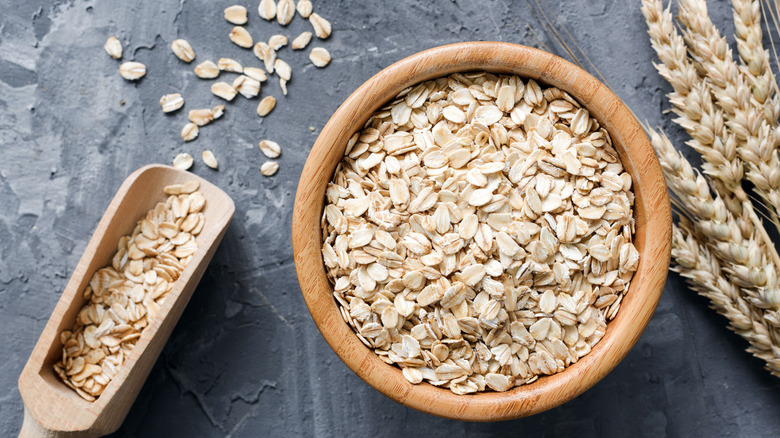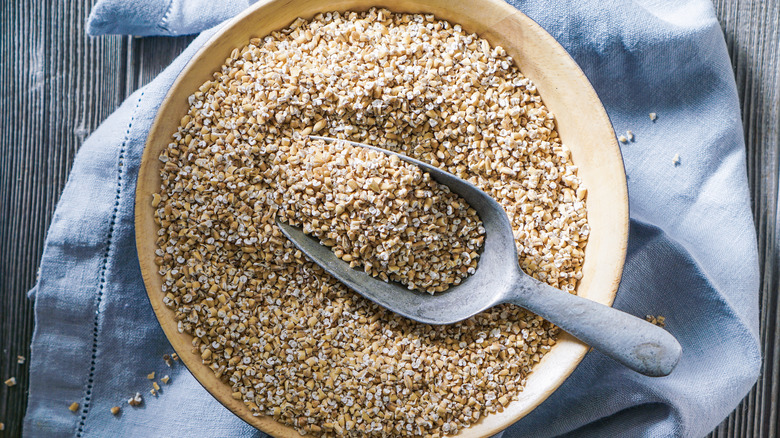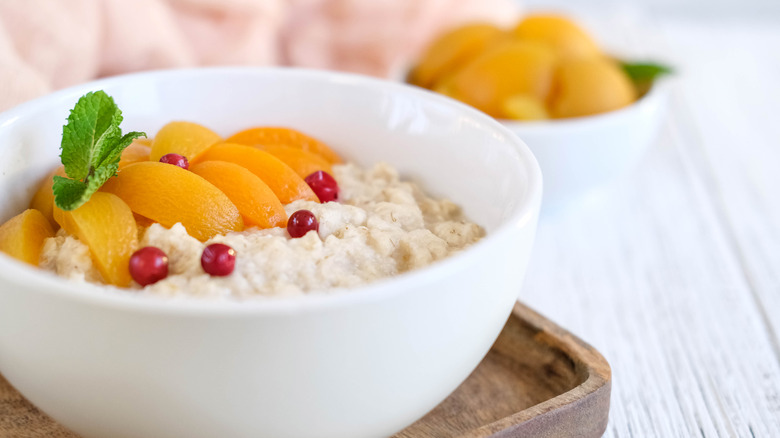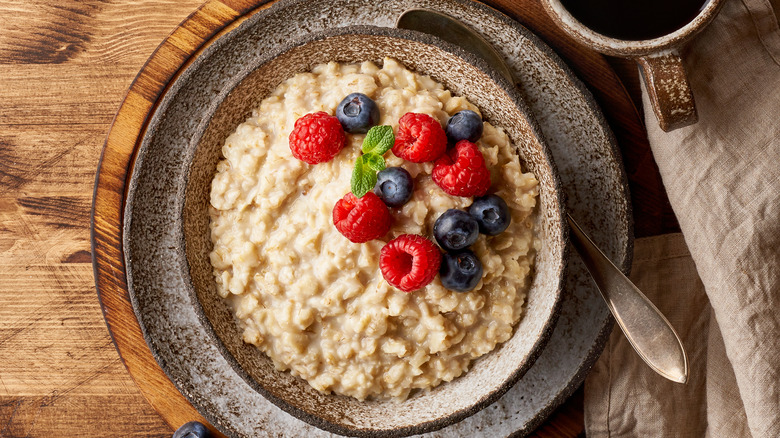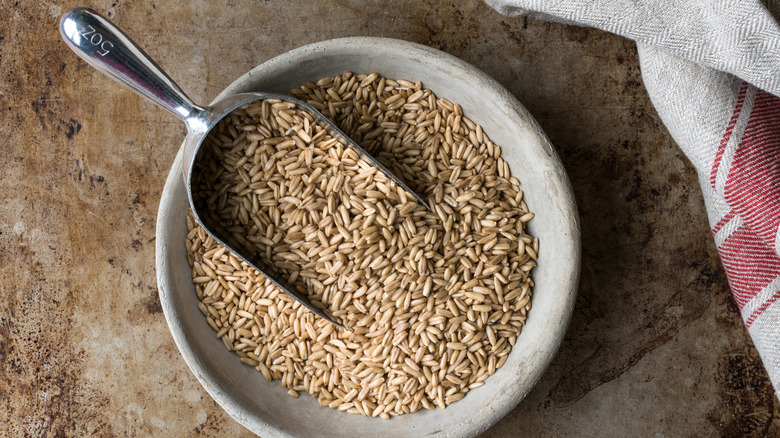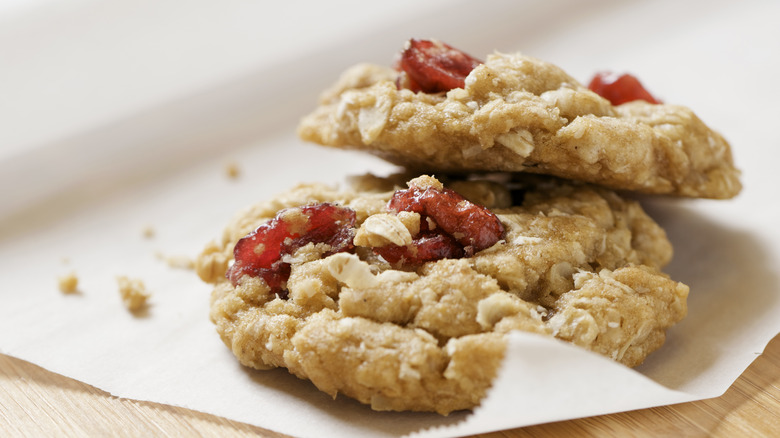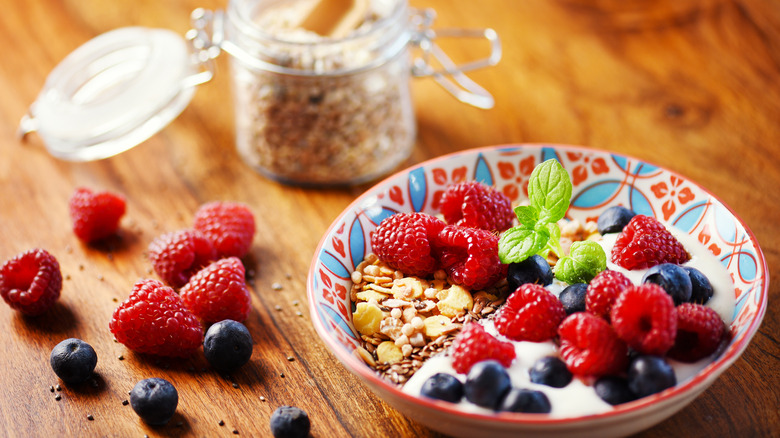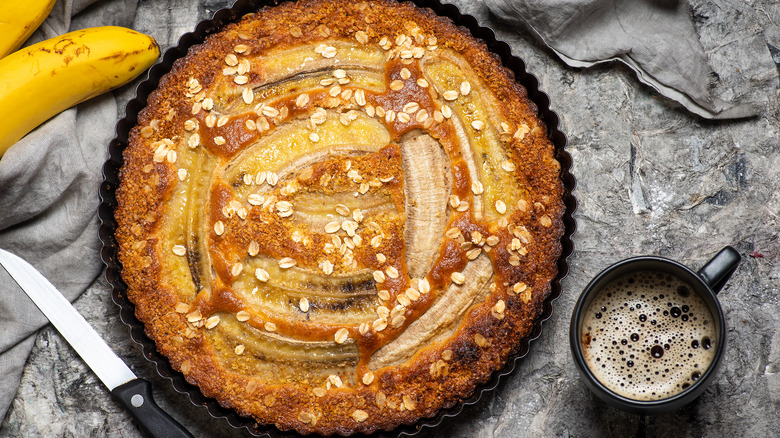8 Types Of Oats And The Best Uses For Each
Whether you like to start off every morning with that perfect bowl of oatmeal, or you prefer your oats in oatmeal raisin cookie form, there's no doubt that oats are a delicious and nutrient-packed ingredient. Although the terms "oatmeal" and "oats" are often used interchangeably, the difference between oatmeal and oats is simple: Oatmeal is actually made of oats, whole grains which are then processed.
Oats themselves are extremely versatile and can be used in many ways apart from just oatmeal recipes. Plus, oats are loaded with health benefits, like being a quality source of fiber, carbs, and protein, not to mention a range of other vitamins and minerals like magnesium, iron, and zinc — but that's no secret. What is more misunderstood about oats is that there are actually eight different kinds, all with different textures, uses, and nutritional benefits. Let's break down each type of oat and how to use them.
Rolled oats (or old-fashioned oats)
Rolled oats are the most classic type that probably first comes to mind when imagining a comforting bowl of oatmeal. Rolled oats, also known as old-fashioned oats, are made by taking whole oat groats (essentially the kernel) and then steaming them. They are then rolled flat. Rolled oats differ from some other oat varieties in that they are minimally processed. Because of its thicker shape, rolled oats can take around five to 10 minutes to cook — while a longer cooking time than some other oat types, this is still a fairly quick-cooking and convenient option for busy mornings.
Not only are rolled oats a go-to choice when it comes to your classic oatmeal, but you'll also want to reach for rolled oats for your baking needs, as they'll make for a chewier cookie with a better texture and shape. Rolled oats can also serve as a great substitute for bread crumbs, making them a tasty upgrade for your meatloaf. Oats will adequately bind the loaf together, without drying out as much as bread crumbs. You can also try rolled oats in pancakes for some added protein, or in granola for a nutritious and flavorful breakfast or snack.
Steel cut (or Irish oatmeal)
Another popular oat variety is steel cut coats, which are also known as Irish oatmeal. You may even occasionally hear them referred to as pinhead oats or coarse oats as well. As you may guess based on the name, the process of making steel-cut oats involves taking the whole oat groat and chopping it with a steel blade. Steel-cut oats are even less processed than rolled oats, making them one of the least processed oat varieties overall, as well as one of the most nutritious, as they're full of soluble fiber and are high in protein.
Since steel-cut oats are essentially whole grains, this variety takes longer to cook, requiring 20 to 30 minutes on the stove before you get that coveted, chewy oatmeal texture. Because this variety isn't pasteurized through steam, this type of oat is best when cooked as opposed to raw, so stick to your rolled oats instead for smoothies or other uncooked uses.
Instant oats
Busy mornings call for quick and convenient breakfasts, and it doesn't get much better than instant oats, made with small pieces of oat groats which are then steamed and rolled. The one downside is that instant oatmeal is slightly less nutritious — because of the smaller size of instant oats, you're sacrificing some of the higher fiber content that you'd find in the less processed steel cut or rolled oats varieties. Instant oatmeal is typically the variety you'll find in prepackaged, pre-cooked format, which while delicious tasting, can often come with an added dose of sugar as well.
But on some days — whether you're on a camping trip or just don't have any clean dishes to spare — you can't beat the convenience of instant oats. When it comes to pre-packaged instant oatmeal, you can whip up a solid breakfast in the packet, with no dishes needed. Just add some water to the package and microwave for a minute or two, depending on the specific package directions. You then have a hearty and satisfying breakfast that's even better when topped with fresh or dried berries, cinnamon, or peanut butter for a boost of protein. Because of the small oat size, this oatmeal is typically on the softer side.
Scottish oats
The defining difference between Scottish oats and Irish oats comes down to texture. To make Scottish oats, aptly named for their popularity in Scotland, whole oat groats are steamed, rolled, and then crushed between large stone wheels, known as millstones. Because they're slowly and finely ground instead of being flattened or rolled, you wind up with a creamier, smoother texture that can be thicker than the average oatmeal. Because of the process they undergo, Scottish oats do have a bit less protein and fiber than you'd find in steel-cut oats, but they're still a healthy and tasty breakfast choice.
Scottish oats are great when enjoyed as oatmeal and loaded with toppings, but they can also be used for flavorful sandwich bread or in oatcakes, a snack that's popular in Scotland as well as internationally, that can be made either sweet or savory. Scottish oats only take about 10 minutes to cook on the stove.
Oat groats
Before you end up with any variety of oatmeal, the process begins with the oat groat, also known as whole oats. After oats have been harvested and had their inedible outermost layer, known as hulls, removed, you're left with oat groats, a highly nutritious grain with a slightly nutty flavor. While they often go on to other stages of processing and becoming other oat varieties, oat groats can definitely be enjoyed, as well. Oat groats are typically selected for their bountiful health benefits, as they're packed with fiber and protein.
Because of their size, oat groats will take the longest to cook compared to every other oat type. You'll want to simmer your oats on the stove for at least 45 minutes. Oatmeal made of oat groats will have a chewier texture, so you can even cook them for up to an hour to soften them as much as possible. Opt for whole oat groats in a traditional oatmeal dish, or even swap groats for your typical rice or lentils in a grain bowl.
Quick oats
If you prefer your bowl of oatmeal to be creamy and smooth, and ready as fast as possible, quick oats may be for you. There's certainly no time wasted when it comes to quick oats, as you can have a batch ready to eat after just a minute or two on the stove. While often compared to instant oats — and the two are quite similar — quick oat grains aren't generally quite as small as instant oats. While instant oats are usually sold in individual packages, quick oats are more commonly purchased in bulk, making them both a more economical option as they are less likely to be filled with sugar and other preservatives.
Unlike instant oats, quick oats can often be used for baking, much like rolled oats can. Try them in baked oatmeal for a chewier, cakier spin on classic oatmeal that's easy to grab and go.
Oat bran
When it comes to oat bran, it comes from the same grain as your typical rolled or steel-cut oats, but unlike your other oat varieties which are made from the whole oat groat, oat bran is the outer layer of the grain. If nutrition is your goal, oat bran is one of the best choices out there, as it's even higher in fiber and antioxidants like protein, iron, thiamine, and magnesium than most oatmeal. It tends to be mushier in texture rather than chewier when compared to other types of oatmeal. An added bonus is that oat bran also cooks in just three minutes or so.
Try toasting your oat bran before cooking to enhance its nutty, sweet flavors, and, apart from using these oats as oatmeal, try adding it to smoothies, or baking them into muffins or bread. Oat bran is an easy addition or substitute for other types of oats or grains, to elevate your dish's texture as well as nutritional benefits.
Oat flour
If you're looking for a gluten-free flour option, oat flour is a nutritious, protein-rich option. Oat flour can either be purchased or made yourself, by adding rolled oats to a blender and blitz until you have a fine, flour-like consistency. Oat flour is a great choice for breakfast classics like pancakes or muffins, along with other delicious baked goods like cookies, cakes, or breads. The great news is that you don't need to convert any measurements either. Oat flour can be substituted for regular flour in equal parts.
You can also easily utilize oat flour to thicken sauces, just keep in mind that while regular flour is mild and relatively tasteless, oat flour tastes like, well, oats. So you may not want to swap in oat flour unless a slightly nutty taste could benefit your dish. A brown butter sauce, a buttery béchamel, or a savory bacon or sausage gravy are all mouth-watering uses.

